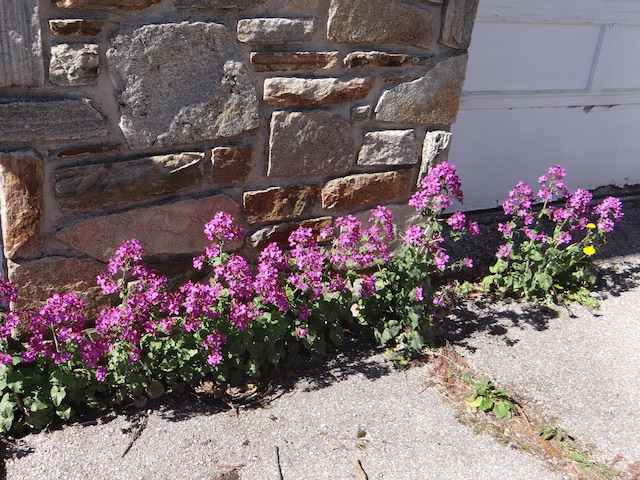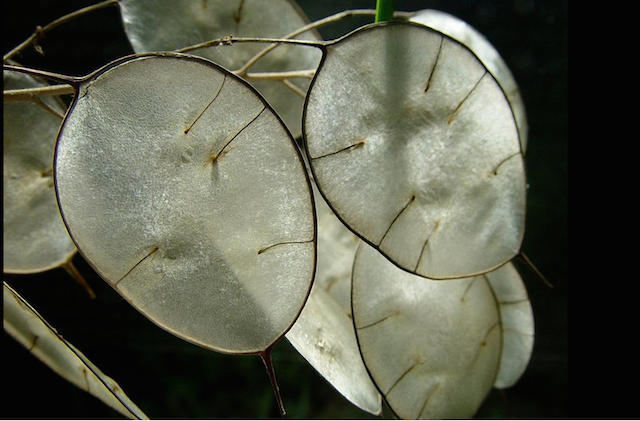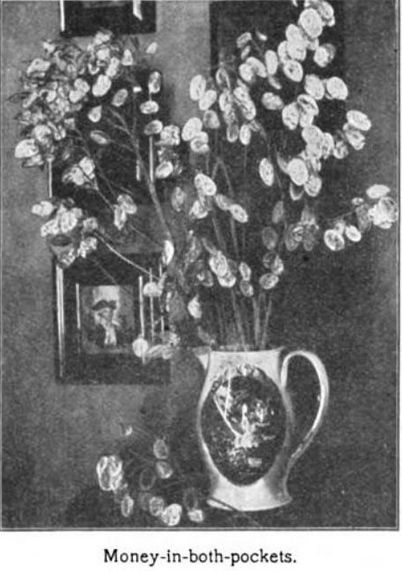This is a plant of many names based on appearance—Money Plant, Silver Dollars, Silver Shillings, Chinese Coins, Pope’s Money, Coins of Judas, Silver Plate, English Penny Flower—I think you sense a theme here… According to Feng Shui, all those “money plants” freely growing in the cracks by the front door will bring wealth Qi into my house.
It is also a plant associated with the moon by shape (thus the name Lunaria) and also to women, witchcraft and charms. It was called Violet of the Moon or Flower of the Cow ( for Greek Io, the Heifer or Horned Virgin). It was supposedly used as one of the seven ingredients for the “Ointment of Flight”, picked on Monday (Moon’s Day) and was used in charms to make a horse throw its shoes and to pick locks. Its women’s virtue name was Honestie, due to the translucency of the seedpod.
An ancient herbal description is thus: “The cod is composed of three films or skins whereof the two outermost are of ouerworne ash color and innermost or that in the middle whereon the seed doth hang or cleave is thin to clear shining like a shred of white satin newly cut from the peece” . And so another name: “White Sattin Floure”
As a member of the mustard family, it actually is edible. Way back when, the peppery roots were used raw in salads or as a boiled vegetable.
The favored use is in garden crafts and dried arrangements. Alice Morse Earle, in Old Time Gardens wrote “In country homes in olden times were found several universal winter posies. On the narrow mantle shelves of farm and village parlors, both in England and America, still is seen a winter posy made of dried stalk of the seed valves of a certain flower—Pricksong flower when notes looked like small pricks” (seed resemblance). Yes! Yet another name for Lunaria annua!
Victorian women spent dull winter days hand painting the seed pods and using translucent dried Lunaria as a component in framed compositions of skeletonized leaves. (To dry Lunaria annua, cut stalks as soon as the green fades from the seedpods and hang in an airy spot.)
This clumping biennial “groweth plentifully” in all the nooks and crannies around my north facing parking pad, its purple-pink flowers (can be white too, but not mine) lending a cheerful air despite all the May rains. It has naturalized widely as a ‘wildflower’ around this country since the Pilgrims arrived with seed in Massachusetts. Apparently 18th century housewives in Boston had small household seed selling enterprises and small packets of Lunaria were put together so that “all may have a little”. You can thank them for helping to spread it everywhere.
As a garden plant, Lunaria annua does well in part sun to semi-shade as a back of the border cottage garden plant. One can select and favor those with the best flowers by removing the inferior types to prevent those from reseeding. They are said to be attractive to long tongued bees, butterflies and birds.





